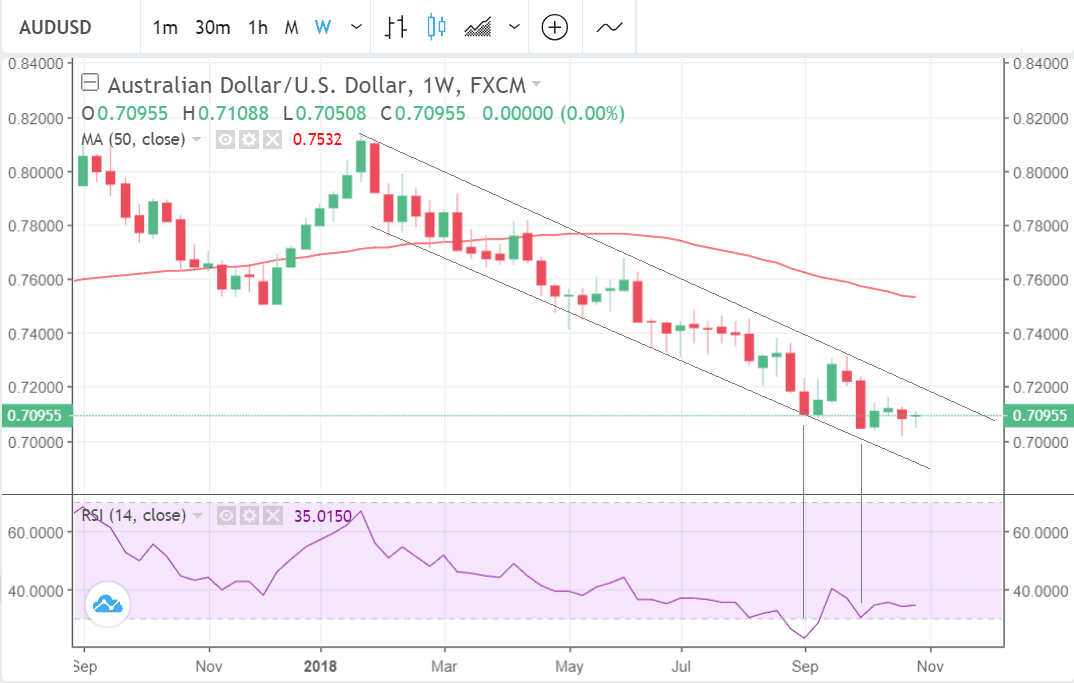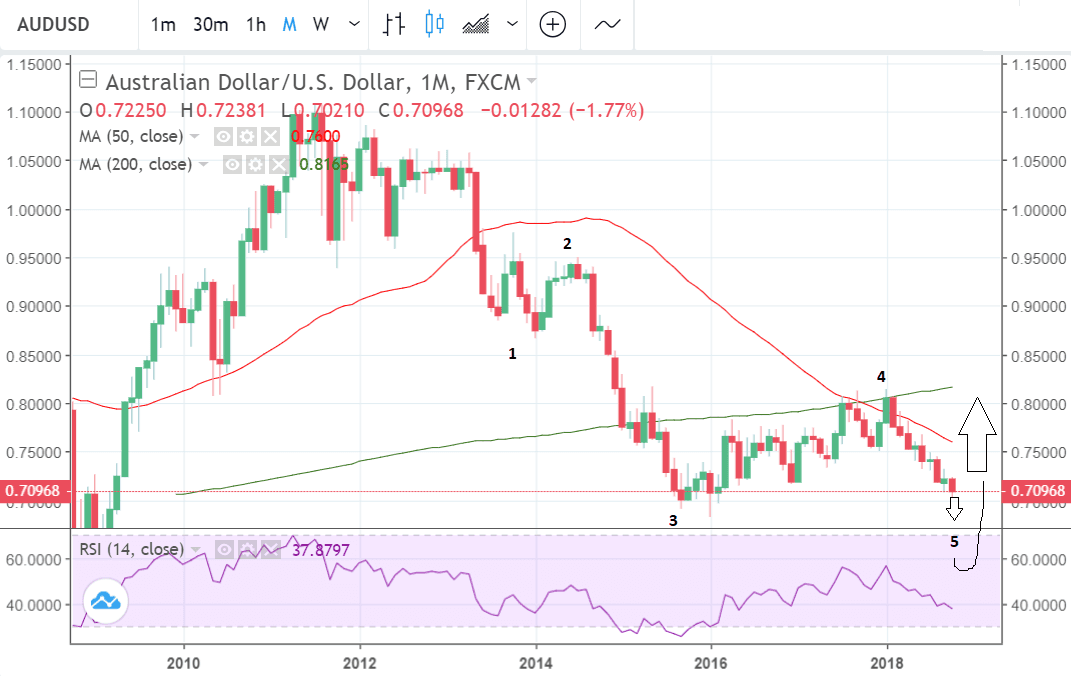Beware an Australian Dollar 'Bear Trap'

Image © Rawpixel.com, Adobe Images
- Australian Dollar may be subject to brief resurrection
- Long-leg'd doji and convergence spell upside
- Yet longer-term downtrend still dominant
The Australian Dollar is showing signs it may be bottoming against the U.S. Dollar and while they are not yet major signs of a reversal there are enough to get analysts talking.
The Aussie Dollar has trended lower through 2018 and is nursing a loss of 8.8% against the U.S. Dollar, a 8.5% against the Yen, a 3.75% loss againt the Euro and a 3.5% loss against the Pound.
While following the trend is often the safest and simplest strategy to pursue, the message to those traders who remain committed to further AUD declines is to stay alert to a reversal.
Evidence from the charts suggests the possibility of a short-term bounce, AUD/USD's RSI momentum indicator, for example, has converged with price at the last two lows, which is a bullish sign.
Convergence happens when the exchange rate makes a new low but the RSI does not follow. It indicates the market lacks downside momentum and could be at risk of a reversal higher.
Upside is also hinted at by the 'long-legged doji' or 'hammer' candlestick pattern which formed on October 26. This is another bullish sign as long as its 0.7021 lows can hold.
"Prior instances of long-legged dojis have been followed by sharp short-term gains, while the diverging RSI suggests bears are losing momentum. The combination of those factors suggests a bounce is due," says Christopher Romano, an analyst at Thomson Reuters.
Positioning data is also supporting a rebound in AUD/USD.
This is data showing how large speculators are betting on currencies in the futures market.
Australian short bets are diminishing which is a sign market sentiment may be rotating. US Dollar longs are "intensifying" which suggests the possibility of an overbought blow-off developing in relation to sentiment around USD.
Advertisement
Bank-beating AUD exchange rates: Get up to 5% more foreign exchange by using a specialist provider to get closer to the real market rate and avoid the gaping spreads charged by your bank when providing currency. Learn more here
How will we know if a Rebound is Afoot?
"A clean break and hold above the 10- and 21-DMAs, as well as 2018's down trend line, would enhance the risk of a short squeeze," says Romano.
Bulls still face risks. Longer-term charts are extremely bearish and although the monthly chart is showing a near-complete Elliot wave, it has still not quite finished. The final wave 5 is usually (but not always) expected to be as long as wave 3 at a bare minimum.
Assuming it is the exchange rate is destined to fall to match the 0.6827 lows.
After wave 5 has finished the pair will then probably rise in a large corrective bull wave higher, so the Elliot analysis is bullish in the medium-term.
A lack of regeneration in Australian government bond yields compared to US Treasury yields which are shooting higher is a further risk to the bullish view.
Yields reflect interest rates since both compensate lenders for inflation attrition. They are also a major driver of currency valuations.
A rise in interest rates usually drives up the host currency, because higher interest rates attract foreign capital inflows with the promise of higher returns.
The long downtrend in USD/AUD has been driven mostly by a divergence between US interest rates, which have been rising, and Aussie rates which have remained largely unchanged.
"The trend of wider Australian-U.S. yield spreads remains a downside risk as does weakness in the Chinese yuan," says Romano.
If the spread remains as wide as it has been and continues to favour higher rates in the US AUD/USD is likely to extend its downtrend.
A strong Yuan matters because the Chinese are the largest importers of Australian goods so a stronger Yuna gives them more buying power.
Also in regard to China, the Australian Dollar is extremely sensitive to the US-China trade war, which if it worsens will weigh on AUD.
The most recent comments from Donald Trump are promising but there is still a risk he will raise tariffs on all Chinese imports later in the year, which if it happens will hit the Aussie hard.
Advertisement
Bank-beating AUD exchange rates: Get up to 5% more foreign exchange by using a specialist provider to get closer to the real market rate and avoid the gaping spreads charged by your bank when providing currency. Learn more here













